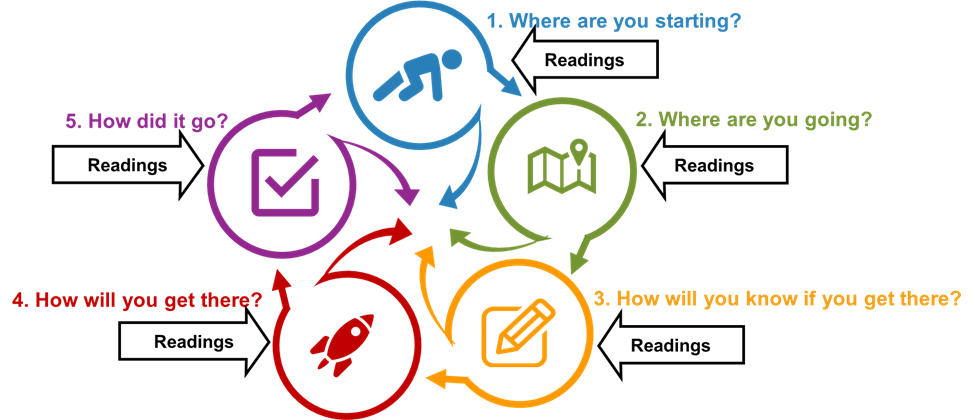
C. Teaching Practices
C8. Course Readings
Course Readings
Selecting Course Readings/Textbooks
While you may be assigned a textbook for your course, if you have the option of selecting course readings or want to add to the pre-selected course readings, you should start by considering your student demographics – what reading level can you expect? What is a reasonable cost? Will students have easy, consistent, and free internet access?
Martin et al., (2017) found “63% of students reported not having purchased a required textbook due to cost.” Reid & Maybee (2021) report “An additional 14% of students dropped and 10% withdrew from a course because of the textbook costs. Surveys of students repeatedly show that a majority of students had not purchased a textbook because of its cost and about a third of students said that not purchasing the textbook negatively affected their grade.” Therefore, you may want to consider alternatives to expensive texts. Options include:
- Open Educational Readings (OER) – books that have a creative Commons license
- Customized textbooks – chapters from various texts that a publisher works with you to select and package
- Course packs or library reserves – articles and other readings that are either printed or made available in the library or your LMS course
- Web-pages – a selection of pages and/or sites that provide the needed material
- Combination of the above
For pros and cons of each option, see the Reid & Maybee article.
Also consider how the students will access the materials:
- Textbooks – will you be relying on significant parts of a text to warrant the cost? When do you need to order these? If these are digital, you may need to coordinate with the IT department. Will students with vision impairments be able to access these?
- Readings on the LMS – if you are adding readings (articles or book chapters, for example) to the LMS, consider how much you can add without copyright infringement
- Readings in the library – if the library has holdings for your course, how will students access them? Can the students access them digitally, can they check them out, or must they read them in the library? Will students with vision impairments be able to access these?
- Printing and duplicating services – if your institution has a print shop, check with them on packaging readings digitally or physically. They may also be able to manage copyrights for you, adding the cost to the student fee for the reading package. Will students with vision impairments be able to access these?
Student cost for course readings
Because students usually do not get course readings as part of their tuition costs, they may have limited funds available. When selecting readings, remember that they may be required to pay for copyrighted articles (either printed or digitally available) and textbooks. Some OER texts are available that provide high quality reading.
Selection considerations
- Any readings you select should be reviewed carefully to match student demographics, but also for currency of material and inclusivity of both authors and content.
- To encourage the student to read, consider providing them with discussion questions based on the readings before the readings are due.
- Lee, et al. (n.d.) suggest “Limit reading to no more than 40 pages a week.”
- If you are copying articles or book chapters to include either digitally or on paper, consider copyright laws and costs. Your library and/or print shop might be able to guide you on this.
Basic steps in selecting readings
- Determine student demographics
- Align readings to course outcomes
- Select format
- Review for quality and match
- Order materials
For detailed steps on selecting readings, see the open resources article by Reid, P., & Maybee, C. (2021). For details on the process, see Worksheet 3.1e – Select Student Readings.
IDI & Course Readings

The following describe actions you can take to use concepts from readings in the IDI model:
Step 1. Where are You Starting?
1.1 Review Course Requirements
- Determine dates for ordering reading material from the bookstore, library and print shop.
- If your institution has a print shop, check with them on packaging readings digitally or physically. Ask if they manage copyrights for you, adding the cost to the student fee for the reading package.
1.2 Identify Student Learning Characteristics
- Determine what courses and content your students have probably been exposed to.
Step 3. How Will You Know If You Get There?
3.1 Develop Assessments & Rubrics
- Select readings with diverse images, content, and articles, including diverse practitioners and scholars (Booker & Campbell-Whatley, 2018, p.20).
- Select readings with a balance of deficit- and asset-based images, examples, and depictions of communities (Sheridan Center for Teaching and Learning, 2020).
- Consider international and diverse experts as well as content examples showing a variety of cultures, peoples, and situations (Addy et al., 2020; Reid & Maybee, 2021, p. 2; Sheridan Center for Teaching and Learning, 2020).
- Consider how your assessments influence students’ motivation to read course material.
- “Limit reading to no more than 40 pages a week” (Lee et al., n.d.).
- “Use open educational resources with different writing styles and voices” (Lee et al., n.d.).
- Use a course workload estimator to determine if your combination of assignments and readings is appropriate.
- Check readings to ensure they are the best options (Reid & Maybee, 2021).
- Map course readings to the learning outcomes.
- If desired, create pre-session quizzes on the homework.
- Write discussion questions focused on readings.
- Add final reading list from Worksheet 3.1e – Select Student Readings to the syllabus, including how students will gain access to them.
- Arrange to have readings available.
- Add readings to course schedule.
Step 4. How Will You Get There?
4.1 Develop & Teach Course
- Use the readings to develop class questions for full class or grouped discussions.
- Distribute discussion questions focused on next class readings.
Step 5. How Did It Go?
5.1 Evaluate Course Success
- Reflecting on student homework, consider if the readings were targeted at the correct reading level.
References
Addy, T. M., Dube, D., & Mitchell, K. A. (2020, August 5). Fostering an Inclusive Classroom. Inside Higher Ed. https://www.insidehighered.com/advice/2020/08/05/small-steps-instructors-can-take-build-more-inclusive-classrooms-opinion.
Lee, K., Gill, S., & Pettit, D. (n.d.). Cognitive Load in Higher Education: Intro to Cognitive Load Theory for eLearning Professionals [Course]. Introduction to Cognitive Load Theory. Retrieved July 9, 2020, from https://canvas.instructure.com/courses/1217991/pages/cognitive-load-in-higher-education.
Reid, P., & Maybee, C. (2021). Textbooks and Course Materials: A Holistic 5-Step Selection Process. College Teaching, 0(0), 1–12. https://doi.org/10.1080/87567555.2021.1987182.
Sheridan Center for Teaching and Learning. (2020). Effective Teaching Is Anti-Racist Teaching. Sheridan Center for Teaching and Learning, Brown University, 1812. https://www.brown.edu/sheridan/teaching-learning-resources/inclusive-teaching/effective-teaching-anti-racist-teaching.
